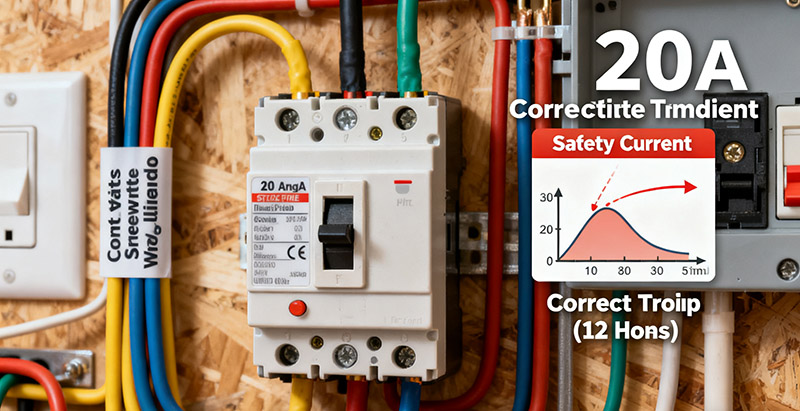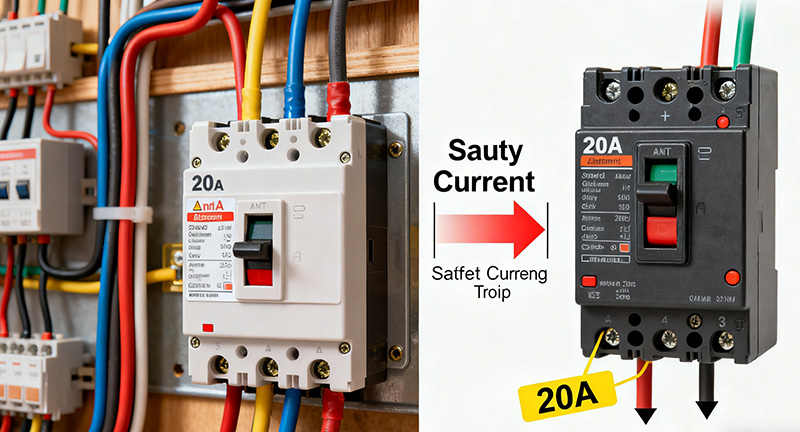Get quick appointment for technical support!
What Size Wire for a 20 Amp Circuit Breaker?
Oct 05,2025
Selecting the correct wire size for a 20-amp circuit breaker is crucial for safety and code compliance. Undersized wiring can overheat and pose fire risks, while oversized wiring, although safe electrically, can be impractical.
In this quick yet comprehensive guide, we’ll explain what gauge wire you need for a 20-amp breaker and other tips for properly wiring a 20-amp circuit.

Quick Answer: Use 12 AWG Copper for a 20A Breaker
For a standard 20-amp circuit breaker commonly used in home branch circuits, the recommended wire size is #12 AWG copper. According to electrical codes, a 12-gauge copper conductor can safely carry the 20 amps of current that the breaker is rated for. In fact, the U.S. National Electrical Code, or NEC, explicitly requires 12 AWG copper as the minimum branch circuit wire size for 20-amp circuits in residences.
This means that 14-gauge wire, which is smaller in diameter, is not acceptable on a 20-amp breaker since 14 AWG is rated for only 15 amps and would overheat if protected by a 20-amp breaker. Using a #14 wire on a 20-amp circuit is a serious code violation and a potential fire hazard.
It is also worth noting that if you choose to use aluminum wiring, which is less common for branch circuits, you generally need a thicker gauge. The equivalent for a 20-amp circuit would be #10 AWG aluminum because aluminum has higher resistance and carries less current per gauge than copper. Always err on the side of a heavier gauge if there is any doubt, and consult local electrical code requirements to ensure full compliance.
Why Proper Wire Size Matters
Wires have a maximum current capacity, known as ampacity. If a wire is too thin for the breaker, it can overheat before the breaker trips, melting insulation and potentially causing a fire hazard. For instance, 14 AWG wire handles up to 15 amps safely, so using it on a 20A breaker risks dangerous overheating. Therefore, a 20A breaker must always use 12 AWG copper wire to ensure the wire can carry the allowed current safely.
Using a thicker wire than necessary is electrically safe but less practical. Larger wires cost more, are harder to install, and may not fit on smaller terminals. While 10 AWG copper can be used on a 20A circuit, it’s usually not worth the added expense or effort. The goal is to match the breaker with the minimum required wire size so the breaker will trip before the wire overheats.
Voltage Drop Considerations: For long runs, even correctly sized wire can lose voltage. To prevent this, electricians often use the next larger wire gauge for runs longer than about 50–100 feet. For example, a long 20A circuit may use 10 AWG to minimize voltage drop and maintain efficiency.
Understanding Ampacity and Code Requirements
Ampacity is the maximum current a wire can safely carry without overheating. Lower gauge numbers mean thicker wires with higher ampacity. According to the NEC charts, a #12 AWG copper wire is rated for 20 amps at 60°C, the standard for most residential circuits. Even if the insulation is rated higher, breaker and terminal limits keep the circuit at 20A. This safety margin is why you must never use 14 AWG on a 20A breaker because it is rated only for 15 amps.
Electrical codes worldwide follow similar rules. In the U.S., the NEC requires 12 AWG copper as the minimum for 20A circuits. Canada’s CEC and IEC-based regions use comparable standards. In metric systems, a 2.5 mm² cable roughly equals AWG #12 and is used for 20A circuits. Always confirm with your local code, but generally 20A = 12 AWG copper minimum.
Continuous vs. Non-Continuous Loads
For circuits running continuously for 3 hours or more, design for 80% capacity, or about 16 amps on a 20A breaker. This does not change the wire size; it remains 12 AWG but ensures safety for steady loads. For typical household or intermittent use, the full 20A is acceptable as long as all components are rated properly.
Copper vs. Aluminum Wire for 20 Amp Circuits
Copper is the ideal choice for most 20A circuits because it provides excellent conductivity, strength, and long-term reliability. Aluminum can also be used but must be one gauge larger to carry the same current safely. Therefore, for a 20A circuit, use #10 AWG aluminum instead of #12 AWG copper.
Because aluminum is less flexible and more prone to oxidation, it is rarely used for indoor branch circuits. If you must use aluminum, ensure all terminals are AL-CU rated and apply anti-oxidant compound to prevent corrosion. In general, 12 AWG copper remains the safest, most efficient, and code-compliant choice for 20A wiring.
Can I Use 14-Gauge Wire on a 20 Amp Breaker?
No, 14 AWG wire is undersized for a 20A breaker. A 14-gauge copper wire is rated for a maximum of 15 amps, so pairing it with a 20A breaker can allow more current than the wire can safely handle. This creates an overheating and fire risk, which is why the NEC prohibits using #14 wire on a 20A circuit. If a circuit requires 20 amps, use 12 AWG copper. If you have 14 AWG wiring, replace it or downgrade the breaker to 15A. Always match the breaker to the correct wire size for safety and compliance.
What If I Use a Thicker 10-Gauge Wire on a 20A Circuit?
Using a thicker wire such as 10 AWG copper instead of 12 AWG is safe and code-compliant for a 20A circuit. The breaker will still trip at 20 amps, and the heavier wire poses no risk since it can carry more current.
However, thicker wire costs more and is harder to install, especially in tight boxes or on terminals rated only for 12 AWG. For most standard runs, 12 AWG already performs perfectly. Use 10 AWG only for long-distance circuits or when voltage drop is a concern.
Recommended Cable Types for 20 Amp Circuits
So far, we’ve discussed the wire gauge, but it’s also important to choose the correct type of cable or conductor for your installation. A 20A circuit can be wired with different cable types as long as the conductors are 12 AWG copper (or equivalent). Here are some common options:
- NM-B (Romex®): Common indoor cable for residential wiring. Used in dry areas like walls, ceilings, and basements.
- THHN/THWN in Conduit: Individual wires pulled through conduit, ideal for garages, workshops, or damp areas.
- UF-B: Outdoor-rated cable that can be buried directly. Best for outdoor circuits like pumps or sheds.
- MC (Metal-Clad): Cable with metal armor for added protection, suitable for commercial or exposed indoor areas.
Always use cable rated for the environment (indoor, outdoor, wet, or dry) and ensure all devices and fittings are rated for 20A and 12 AWG wire.
Final Tips and Best Practices
- Use Consistent Wire Size: Keep all wiring on a 20A circuit at 12 AWG copper. Mixing wire sizes can cause overheating and safety issues.
- Match Outlets and Switches: You can use 15A receptacles on a 20A circuit if there’s more than one outlet, but wiring must remain 12 AWG. Use 20A-rated devices for single-outlet circuits.
- Plan for Future Needs: If future upgrades are possible, you can install 10 AWG wire now, but never increase breaker size without professional evaluation.
- Follow Local Codes: Always check local electrical regulations and safety requirements. Some areas require GFCI or AFCI protection for 20A circuits. When in doubt, consult a licensed electrician.
Conclusion
In summary, the correct wire size for a 20 amp circuit breaker is 12-gauge copper. This ensures your wiring can handle the load safely and meets the requirements of electrical codes. Using the proper gauge prevents hazards like overheating and helps your electrical system run efficiently. If you’re planning a DIY project or an installation, always double-check the wire size and type for the circuit’s amperage. It’s a quick check that can make the difference between a safe setup and a dangerous one.
Key Takeaway: Always use #12 AWG copper wire for a 20-amp breaker circuit. This simple rule will keep you on the right side of electrical safety and regulations. Choosing certified, reliable materials from trusted suppliers guarantees performance, safety, and long-term value for every project.
--- END ---

